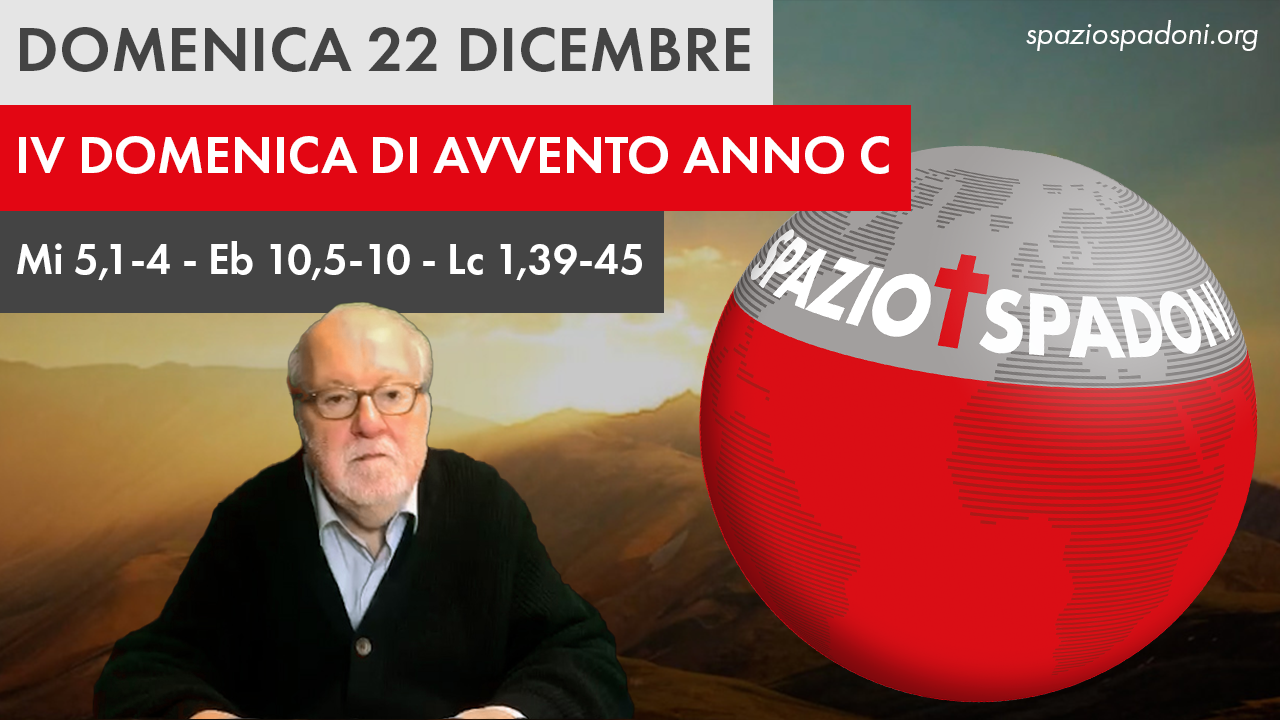
IV Sunday Of Advent C
Readings: Mi 5:1-4a; Heb 10:5-10; Lk 2:39-45
“Where will the Messiah be born?” all Israel wondered. The answer is drawn (First Reading: Mi 5:1-4th) from the prophetic book of a contemporary and perhaps disciple of Isaiah, the farmer Micah from the village of Moreset, 35 kilometers southwest of Jerusalem. An impassioned and very harsh preacher against the corruption of the politicians and high clergy of his time – E 3:3: “They devour the flesh of my people and tear the skin off them, they break their bones and tear them to pieces like meat in a pot, like boiled meat in a cauldron” – Micah opens the horizon in the finale to a light of messianic hue. From Bethlehem, a small village but David’s homeland, a parturient will give birth to a new David, a king of peace and joy, the source of cosmic harmony.
This Christ who enters the world “to sanctify us through the offering of his body, made once for all” (Second Reading: Heb. 10:5-10), is from Mary immediately brought to her elderly relative Elizabeth, who is also pregnant. Mary’s visit to Elizabeth should be read along the lines of various Old Testament passages (2 Sam 6:9,11,18; 1 Chr 15:28; 2 Chr 5:13; Jdt 13:18; Deut 28:3-4).
- Mary is the ark of the covenant:
(a) before which we feel unworthy: “To what do I owe that the mother of my Lord should come to me?” (1:43), exclaims Elizabeth, like David who had said, “How shall the ark of the Lord come to me?” (2 Sam 6:9);
(b) which remains three months (1:56-> 2 Sam 6:11: “The ark of the Lord remained three months in the house of Obed-Edom of Gath, and the Lord blessed Obed-Edom and all his house”);
(c) in front of which it dances: “the child danced with joy in my lap” (1:44), like David in front of the ark (2 Sam 6:14,16);
(d) in front of which blessing and praise burst forth: Elizabeth “anaphonesen” (1:42), loudly raising the liturgical cry of the ark’s attendants (1 Cr 15:28: “All Israel accompanied the ark of the covenant of the Lord with shouts”; cf. 16:4; 2 Cr 5:13);
(e) incorruptible ark, hidden for the end of time (2 Mac 2:4-8: “It was also said in the writing that the prophet (Jeremiah), having obtained a response, commanded that they should follow him with the tent and the ark. When he arrived at the mountain where Moses had gone up and contemplated the inheritance of God, Jeremiah went up and found a cave-shaped room and there he introduced the tent, ark and altar of incense and barred the entrance. Some of his retinue then returned to mark the way, but they never found the place again. Jeremiah, learning of this, rebuked them, saying, “The place must remain unknown, until God has gathered the whole of his people together and shown himself propitious. Then the Lord will show these things, and the glory of the Lord and the cloud will be revealed, as it appeared over Moses, and as it was when Solomon asked that the place be solemnly sanctified’”; cf. Rev. 11:19): from such reflection will arise the dogma of Mary’s Assumption. - Mary is the blessed one (1:42,45,48), because in her is embodied the Blessed One: it is the only beatitude ad personam in the New Testament with that of Peter in Mt 16:17. Mary is “the summary woman of the feminine open to God and his plan: Joel, Judith, Sarah, Rebekah, Leah, Rachel, Tamar, Rahab, Bathsheba, Ruth, Anna and Elizabeth” (G. Bruni). And only in the Holy Spirit (1:41) is it possible to praise Mary.
On this occasion Elizabeth proclaims the blessedness of Mary: “Blessed is she who believed in the fulfillment of the words of the Lord” (Lk 1:45). Mary is blessed because she is a woman of faith. Her happiness consists in the trust she has placed fully in her Lord. She is clearly a model for every believer, blessed precisely because she is a believer. Forcefully Augustine emphasizes, “Beatior Maria percipiendo fidem Christi quam concipiendo carnem Christi”; faith is a source of greater happiness than being a mother according to the flesh. The great doctor continues, “It would have availed Mary nothing to be close to motherhood, if she had not been content to bear Christ more in her heart than in her flesh.” The value of Mary’s motherhood thus lies in the original attitude of faith that made it possible. - Mary’s journey is missionary: for Luke there is no “going” that is not determined by the Spirit. The “in haste” of v. 39 corresponds to the “Greet no one on the way” of Lk 10:4, and the “entered the house greeted” of Lk 1:40 to the “Into whatever house you enter, first say, ‘Peace to this house’” of Lk 10:5, the typical admonitions to disciples on mission.
- Mary’s journey is diaconal: Mary remains in service to her elderly relative until the birth of John. She is the “handmaid of the Lord” (1:38) where he wants to be served, in the brethren.
